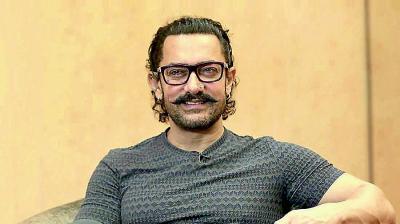No child’s play
The blood-curdling film tells the story of two-year-old Pihu (played by Myra Vishwakarma), who wakes up one morning to find herself all alone at home.
Vinod Kapri’s latest drama thriller, Pihu is a profoundly intense watch. In a tête-à-tête the director takes us through the unusual production of this film and the joys of putting IT together.
A toddler’s vulnerability triggers a protective instinct in us, and that is why the trailer of Vinod Kapri’s Pihu left many of us horrified. The blood-curdling film tells the story of two-year-old Pihu (played by Myra Vishwakarma), who wakes up one morning to find herself all alone at home. In a chilling scene, we see her trying to rouse her lifeless mother, but to no avail. Murphy’s law exercises its diabolical power and an unsupervised Pihu tiptoes and gets trapped in a fridge, precariously climbs up wall cabinets and a window railing, switches on electrical gadgets and even the gas stove and invariably does everything a toddler would, had she been left alone at home. What intensifies our panic is the knowledge that the film is based on a true story, one that the director came across in a daily in 2014.
The trailer rightly states that the film captures ‘Every parent’s worst nightmare’, but director Vinod tells us in a candid chat that the sole intention of the film isn’t to petrify people. “Yes, the film is a thriller, but it’s a lot more than that as well. When I conceive any film, I ask myself, ‘What are you trying to say through this film’. I can’t do a film if it lacks an underlying message,” says the director who already has a National Award for the documentary Can’t Take This Shit Anymore under his belt. And so, Pihu is also a story about family and relationships and gives us a peek at what we stand to lose when we become complacent in our relationships. “The film has a strong, underlying social message. It shows us what happens when we take our near and dear ones for granted. The simple storyline will resonate with viewers because they will realise that it is happening in their own lives, every day,” shares the director.

Vinod also tells us how he opted for the understated route when it came to contriving thrills. “In Indian cinema, people often resort to smoke effects and lightning and thunder to make scenes scary. But there’s no need for over-the-top gimmicks. Here the audience knows that the child doesn’t know she is in danger and it is enough to scare you. Anything she does will play on your mind. So the way you create your character is important,” he says. The director also wanted the film to be devoid of music, but he says his insecurities got the better of him. “I had doubts about whether the film would get too boring without music. So, I used it to a minimum and at appropriate places. But, if I had to make the film today, I would make it without music, because I know the film will work even without it,” he says.
Since we get to enjoy a seamless, finished project, we hardly wonder about the challenges that bog down a director during the making of a film. Vinod tells us how, right from raising money for the film, making Pihu was an uphill battle. “When I approached producers, most of them felt that it would be impossible to pull off a 100-minute film that had a single character which was being played by a child,” reveals the director. A friend helped him with part of the funds, but then he had to turn to film festivals to garner the reputation required to seduce producers into shelling out the remaining chunk.
In addition to budget constraints, there was also the aspect of working with a toddler. “When I started shooting with Myra, she was two years and five months. I knew that I couldn’t direct her and also that it would be impossible to ask her to do multiple takes. So we kept three cameras rolling throughout the shoots and tweaked scenes to match her behaviour patterns,” narrates Vinod. In addition to this, props seen in the film were sourced from Myra’s house, so that she felt comfortable in her new home. “We put her in different situations, in a controlled environment, and captured her reactions and expressions. We could only do a single take, and we had to get it right or use what we got. That’s why some of the scenes in the film weren’t there in my screenplay. In a lot of ways, Pihu directed the film. Even in the film, I’ve given an additional screenplay credit to Pihu,” laughs the director.
The biggest challenge was editing the film because they ended up with 64 hours of footage. “Out of the two hours shot every day, we would find about one minute of usable footage,” shares the director. As the film lacked rigid sequencing, many editors refused to work on the film. Finally, Vinod found help in a junior editor who agreed to invest a sizeable amount of time in editing the film. “This was not a regular film, you had to have patience. It took about a year to edit the film and then there were 17 to 18 cuts before the final product,” discloses the director.
Vinod doesn’t believe in drawing distinctions between commercial and art cinema, instead, he says there are only good or bad films. “My conscience told me that Pihu was a good story, and so I went ahead, against all odds,” he concludes.


















